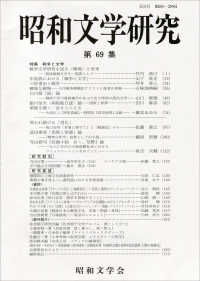- ホーム
- > 洋書
- > 英文書
- > Science / Mathematics
Full Description
Lessons learned in the last several years have given clear indications that the prediction and efficient monitoring of disasters is one of the critical factors in decision-making process. In this respect space-based technologies have the great potential of supplying information in near real time. Earth observation satellites have already demonstrated their flexibility in providing data to a wide range of applications: weather forecasting, person and vehicle tracking, alerting to disaster, forest fire and flood monitoring, oil spills, spread of desertification, monitoring of crop and forestry damages.
This book focuses on a wider utilisation of remote sensing in disaster management. The discussed aspects comprise data access/delivery to the users, information extraction and analysis, management of data and its integration with other data sources (airborne and terrestrial imagery, GIS data, etc.), data standardization, organisational and legal aspects of sharing remote sensing information.
Contents
Use of Geo-Information technology in large disasters.- Geoinformation-Based Response to the 27 May Indonesia Earthquake - an Initial Assessment.- The Application of Geo-Technologies after Hurricane Katrina.- Application of Remote Sensing for Damage Assessment of Coastal Ecosystems in India due to the December 2004 Tsunami.- Increasing the Use of Geospatial Technologies for Emergency Response and Disaster Rehabilitation in Developing Countries.- Remote Sensing Technology for Disaster Monitoring.- Adopting Multisensor Remote Sensing Datasets and Coupled Models for Disaster Management.- Nearshore Coastal Processes Between Karwar and Bhatal, Central West Coast of India: Implications for Pollution Dispersion.- Landslide Hazard Zonation in Darjeeling Himalayas: a Case Study on Integration of IRS and SRTM Data.- Monitoring and Interpretation of Urban Land Subsidence Using Radar Interferometric Time Series and Multi-Source GIS Database.- Extending the Functionality of the Consumer-Grade GPS for More Efficient GIS and Mapping Applications.- System Architectures for Access of Geo-Information.- Interoperable Access Control for Geo Web Services in Disaster Management.- Spatial Data Infrastructure for Emergency Response in Netherlands.- Geocollaboration in Hazard, Risk and Response: Practical Experience with Real-Time Geocollaboration at Québec Civil Security.- On-line Street Network Analysis for Flood Evacuation Planning.- Multi-user tangible interfaces for effective decision-making in disaster management.








